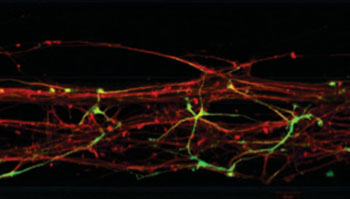Bioreactor Culture of Dopamine-Producing Neurons May Lead to Personalized Treatment of Parkinson's Disease
By LabMedica International staff writers
Posted on 06 Jul 2015
By developing a procedure for transforming skin cells into functional dopamine-producing neurons, researchers have taken an important first step towards the development of personalized treatment of Parkinson's disease.Posted on 06 Jul 2015
Parkinson's disease is characterized by the gradual loss of dopamine-producing neurons in the Substantia nigra section of the midbrain. So far there is no drug treatment available to halt or reverse this process.

Image: Neurons cultivated with the help of ordinary skin cells create a three-dimensional network on a chip (Photo courtesy of Dr. Edinson Lucumi Moreno, University of Luxembourg).
Investigators at the University of Luxembourg (Luxembourg City) have applied the latest innovations in developmental biology and microfluidic cell culture to generate a biologically realistic and economically efficient route for personalized drug discovery for Parkinson's disease. The investigators initially converted normal skin cells into induced pluripotent stem cells (iPSCs) and then differentiated the iPSCs into dopaminergic neurons within three-dimensional microfluidic cell culture bioreactors.
Results published in the June 7, 2015, edition of the journal Lab on a Chip revealed that microbioreactor culture was as efficient as macroscopic culture, with up to 19% of differentiated neurons immunoreactive for tyrosine hydroxylase, the penultimate enzyme in the dopamine biosynthetic pathway.
"We have the neurons grow in a gel that yields a far better model of their natural, three-dimensional environment," said senior author Dr. Ronan Fleming, leader of the systems biochemistry group at the University of Luxembourg. "In drug development, dozens of chemical substances can be tested for possible therapeutic effects in a single step. Because we use far smaller amounts of substances than in conventional cell culture systems, the costs drop to about one-tenth the usual. A further advantage is that the bioreactors can be loaded with cells originating from the skin cells of individual Parkinson's patients. This is an important step towards personalized drug development."
Related Links:
University of Luxembourg










 (3) (1).png)


